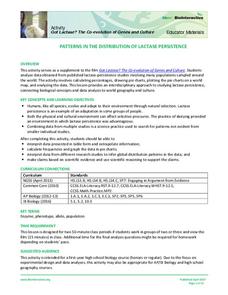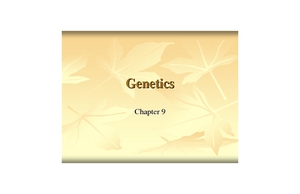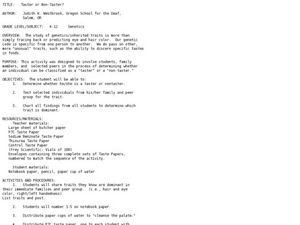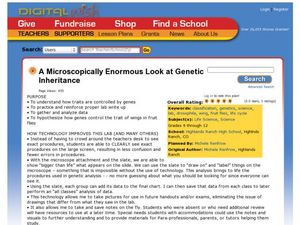Curated OER
Genetics
Trace simple genetic patterns of inheritance through a small population. Your students create a family pedigree that traces a genetic condition through several generations.
Howard Hughes Medical Institute
Patterns in the Distribution of Lactase Persistence
We all drink milk as babies, so why can't we all drink it as adults? Examine the trend in lactase production on the world-wide scale as science scholars analyze and interpret data. Groups create pie charts from the data, place them on a...
Curated OER
The Probabilities of Problems: A Look at Genetic Inheritance
Discuss an article about families affected by genetic disorders and their decisions about whether or not to evaluate their own genetic information. Investigate four different inherited disorders. Participate in a probability exercise....
Curated OER
Take Home Lab: What Are Some Traits in Your Family?
High schoolers use this following the study of pedigree designs and human genetics. Four pedigree designs are prepared of your (student's) family's genetics. They construct the pedigree representing two, three, or four generations.
Howard Hughes Medical Institute
Recent Adaptations in Humans
You've probably spent plenty of time discussing animal adaptations with your young biologists, but what about human adaptations? Explore the evolving traits of humankind through an interactive that combines text and video clips. Scholars...
Curated OER
Genetics
Students create a checklist of traits common in all of their families. Uisng a table, they compare and contrast their family members to non-family members. They also review dominant and recessive traits and discuss how knowing about...
Curated OER
Genetic Testing for Disease Susceptibility
Students explore how testing for particular genetic variations can help people to make decisions in lifestyle and health care choices. They analyze a Web-based case study, participate in class discussion, view video segments and...
Curated OER
Taster of Non-Taster?
Students investigate their own inherited traits by using taste papers. In this genetic traits lesson, students test their ability to taste various substances, which is determined by inherited genetic traits. They take home taste papers...
Curated OER
Family Traits
Young scholars investigate the study of pedigree designs and human genetics. They construct the pedigree representing two, three, or four generations. They investigate their family members' traits for ear lobe attachment, tongue...
Curated OER
Paint's Family Tree
Learners sort and classify the genetic traits of horses. In this heredity and genetics lesson, students read dialogue in a skit in which specific physical traits of several horses are described and a horse family tree is created....
Curated OER
Real Family Genetics
Students research genetic disease and mutation causing traits in family pedigrees simulated in a class activity. Students are each assigned a genetic trait and a "spouse" and must conduct research on their traits and the probability of...
Curated OER
A Microscopically Enormous Look at Genetic Inheritance
Students use microscopes to examine fly families and analyze their genetic inheritance. In this genes lesson plan, students also use the chi square for comparing genes and compare the class results as a whole.
Curated OER
Heredity (Mendelian Genetics)
Pupils observe and record observations of whether a person is a taster or nontaster. They test selected individuals from their families and peer groups and chart all findings to determine which trait (e.g. taster or non-taster) is dominant.
Curated OER
Genetic Variation
Students study families and their genetics. In this investigative lesson students explain how variations in genetics can be harmful and how some can help with survival.
Curated OER
Family Pedigrees
Students work as a class to first construct a pedigree of a popular singer, showcasing the singing gene being passed down through the generations. Students then make their own family pedigree and follow two traits through their family...
Curated OER
Taster or Non-Taster?
Students conduct a simple experiment to determine if a trait has been passed from a family member to them.
Personal Genetics Education Project
How Does Ancestry Testing Work? Exploring Admixture Testing
Find out the science behind ancestry testing! Investigators watch a video exploring how ancestry works before participating in a hands-on group activity. Scholars role play scientists while learning about testing protocols and test...
Curated OER
Oompah Loompa Genetics
In this genetics worksheet, students use descriptive information about the different types of Oompa Loompas to show genotype and phenotype plus dominant and recessive traits. This worksheet has 12 problems to solve.
Curated OER
The Value of Genetic History
Students research and assemble their own pedigrees using star patterns for each family member and coloring in various dominant traits. They arrange these patterns on long strips of paper making large, colorful family pedigrees.
Curated OER
The Value of Genetic History
Young scholars explore their genetic background. They assemble their own pedigrees using star patterns for each family member and identifying various dominant traits. Predictions are made for future offspring.
Curated OER
A Tasteless Tasty Test
Students review the inheritance patterns of simple dominant and recessive traits in humans. They use PTC tasting as a model trait. Each student determines whether or not they are a taster using PTC paper then they compile and discuss the...
Curated OER
Patterns of Heredity
A family tree of dogs guides learners through this activity, in which students analyze the pedigree. With a key describing the genetic attributes (tall dominant, short recessive, or male/female), learners complete five questions about...
Curated OER
TECH: Geneticist
A brief PowerPoint is used to introduce the class to the field of genetics by explaining the fields of work, the education required, and the job prospects. A trait inventory worksheet is completed by individuals, and then they gather...
Curated OER
Human Heredity II
Using deductive skills and reasoning based on the data provided about a family's blood genotype, blood phenotype, chromosomes, and genetic conditions, 9th graders answer the questions below. The conditions discussed are Down Syndrome and...

























